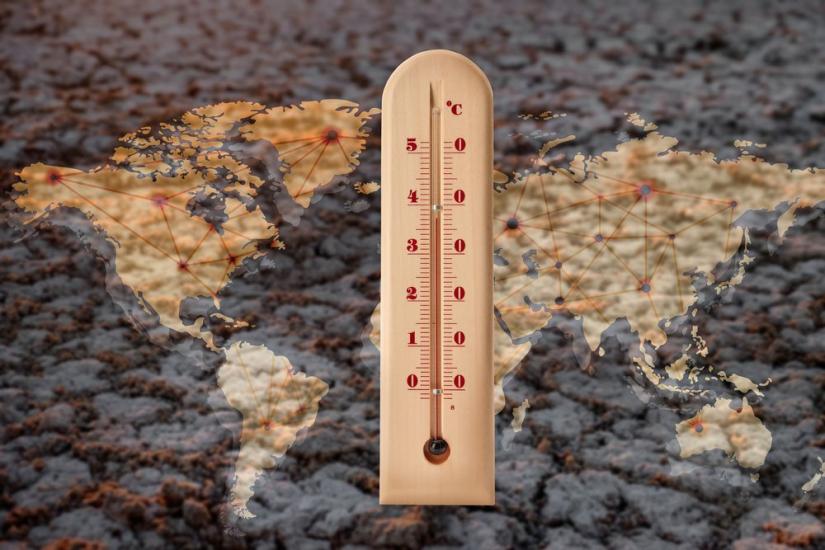 A chilling Australian policy paper outlining a doomsday scenario if climate catastrophe is not dealt with suggests that by 2050, there could see irreversible damage to global climate systems resulting in a world of chaos where political panic is the norm and humans are on a path facing the end of civilization.
A chilling Australian policy paper outlining a doomsday scenario if climate catastrophe is not dealt with suggests that by 2050, there could see irreversible damage to global climate systems resulting in a world of chaos where political panic is the norm and humans are on a path facing the end of civilization.
Experts say that the worst thing about it is that it is actually a fairly calm and rational look at just how bad things could get if greenhouse gas emission into the environment is not curbed within a short time, reports USA Today.
The scenarios "do not seem that far-fetched to me. I do not think there is anything too crazy about them," said Adam Sobel, a professor of applied physics and mathematics at Columbia University in New York City who studies atmospheric and climate dynamics.
The paper was written by an independent think tank in Australia called Breakthrough National Centre for Climate Restoration. It offers a scenario for 2050 in a world where carbon emissions were not lowered enough to keep the global temperature from rising.
Last year's United Nation's Intergovernmental Panel on Climate Change report said the world’s nations must quickly reduce fossil fuel use to keep the rise in global temperatures below 1.5°C.
The transitions, the report said, must start now and be well underway in the next 20 years.
The Australian report imagines a world where that did not happen and global temperatures warmed by 3°C or even more.
While that may not seem like a lot, on a worldwide scale it is expected to result in massive, catastrophic shifts to the weather, agriculture and even the habitability of some areas.
"3°C by 2100 is a pretty middle-of-the-road estimate. It is not extreme and it is totally believable if serious action is not taken," Sobel said.
The writers say their scenario offers a "glimpse into a world of 'outright chaos' on a path to the end of human civilization and modern society as we have known it, in which the challenges of global security are simply overwhelming and political panic becomes the norm."
Their scenario follows this outline:
2050
In the years leading up to 2050, policy makers fail to cut greenhouse gas emissions.
The case for the global climate-emergency mobilization necessary to keep temperatures from rising is "politely ignored."
Global greenhouse gas emissions peak in 2030 and begin to fall due to a drop in fossil fuel use, but damage has been done and warming reaches 3°C.
By 2050, sea levels have risen 1.6ft and are projected to increase by as much as 10ft by 2100.
Globally, 55% of the population lives in areas subject to more than 20 days of lethal heat a year, beyond the human threshold of survivability.
North America suffers from devastating weather extremes, including wildfires, heatwaves, droughts and flooding.
China's summer monsoons fail and water in Asia's great rivers are severely reduced from the loss of more than one-third of the Himalayan ice sheet.
A billion people displaced
Within 30 years from today, ecosystems in coral reefs and the Amazon rainforest collapse, affecting fishing yields and rainfalls.
Deadly heat conditions turn many areas unliveable, resulting in more than a billion people being displaced in West Africa, tropical South America, the Middle East and South-East Asia.
Two billion people globally are affected by lack of water. Food production falls by one-fifth as droughts, heat waves, flooding and storms affect crops.
Rising ocean levels make some of the world's most populous cities uninhabitable, including Mumbai, Jakarta, Canton, Hong Kong, Shanghai, Lagos, Bangkok and Manila. Billions of people must be relocated.
This leads to fights over land, resources and water and potentially to war and occupations.
All too possible
The scenarios given in the paper are all too likely, experts say.
Jonathan Patz is a physician and director of the Global Health Institute at the University of Wisconsin-Madison. He has been studying the health effects of global warming for two decades.
"There are studies showing a doubling of the number of people at risk for hunger by mid-century because of droughts," he said. "And a wider prevalence of infectious diseases like malaria, dengue and the Zika virus. It could result in forced migrations and massive refugee problems."
He noted that just before the Syrian civil war began in 2011, one of the area's most severe droughts on record pushed rural to urban migration rates to four times normal and resulted in food riots.
 Others
Others
31105 hour(s) 29 minute(s) ago ;
Evening 08:23 ; Saturday ; May 04, 2024
Humans will perish in 31 years, warns study
Send
Bangla Tribune Desk
Published : 06:00, Jun 11, 2019 | Updated : 08:33, Jun 11, 2019
Published : 06:00, Jun 11, 2019 | Updated : 08:33, Jun 11, 2019
0 ...0 ...
/pdn/srj/
Topics: Top Stories
- KOICA donates medical supplies to BSMMU
- 5 more flights to take back British nationals to London
- Covid19: Rajarbagh, Mohammadpur worst affected
- Momen joins UN solidarity song over COVID-19 combat
- Covid-19: OIC to hold special meeting
- WFP begins food distribution in Cox’s Bazar
- WFP begins food distribution in Cox’s Bazar
- 290 return home to Australia
- Third charter flight for US citizens to return home
- Dhaka proposes to postpone D8 Summit
Unauthorized use of news, image, information, etc published by Bangla Tribune is punishable by copyright law. Appropriate legal steps will be taken by the management against any person or body that infringes those laws.
Bangla Tribune is one of the most revered online newspapers in Bangladesh, due to its reputation of neutral coverage and incisive analysis.
F R Tower, 8/C Panthapath, Shukrabad, Dhaka-1207 | Phone: 58151324; 58151326, Fax: 58151329 | Mob: 01730794527, 01730794528


